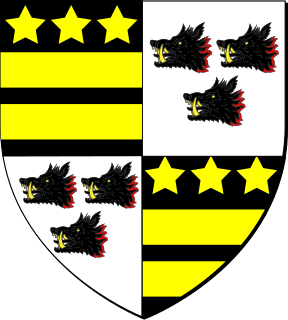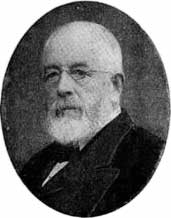Related Research Articles

Earl of Romney is a title that has been created twice.

Earl of Lonsdale is a title that has been created twice in British history, firstly in the Peerage of Great Britain in 1784, and then in the Peerage of the United Kingdom in 1807, both times for members of the Lowther family.

Earl of Cottenham, of Cottenham in the County of Cambridge, is a title in the Peerage of the United Kingdom. It was created in 1850 for the prominent lawyer and Whig politician Charles Pepys, 1st Baron Cottenham. ) He served as Lord Chancellor from 1836 to 1841 and from 1846 to 1850. Pepys had already been created Baron Cottenham, of Cottenham in the County of Cambridge, in 1836, and was made Viscount Crowhurst, of Crowhurst in the County of Surrey, at the same time he was given the earldom. These titles are also in the Peerage of the United Kingdom. The viscountcy is used as a courtesy title for the Earl's eldest son and heir apparent.

Viscount Scarsdale, of Scarsdale in Derbyshire, is a title in the Peerage of the United Kingdom. It was created in 1911 for the prominent Conservative politician and former Viceroy of India George Curzon, 1st Baron Curzon of Kedleston, who was created Earl Curzon of Kedleston at the same time and was later made Marquess Curzon of Kedleston.

Viscount St Davids, of Lydstep Haven in the County of Pembroke, is a title in the Peerage of the United Kingdom. It was created in 1918 for John Philipps, 1st Baron St Davids. The Philipps family descends from Sir John Philipps, who represented Pembrokeshire in the House of Commons. In 1621 he was created a Baronet, of Picton Castle in the County of Pembroke, in the Baronetage of England. His grandson, the third Baronet, also sat as Member of Parliament for Pembrokeshire. He was succeeded by his son, the fourth Baronet. He represented Pembroke and Haverfordwest in Parliament. His son, the fifth Baronet, sat for Haverfordwest. He was succeeded by his younger brother, the sixth Baronet. He represented Carmarthen, Petersfield and Pembrokeshire in the House of Commons.

Baron Carbery, of Carbery in the County of Cork, is a title in the Peerage of Ireland. It was created in 1715 for George Evans, with remainder to the heirs male of his father and namesake George Evans, a supporter of William and Mary during the Glorious Revolution, who had earlier declined the offer of a peerage. After his elevation to the peerage Lord Carbery represented Westbury in the House of Commons. He was succeeded by his eldest son, the second Baron. He also sat as Member of Parliament for Westbury. His grandson, the fourth Baron, briefly represented Rutland in Parliament. He was succeeded by his uncle, the fifth Baron. On his death the line of the eldest son of the first Baron failed. He was succeeded by his first cousin once removed, the sixth Baron, who had previously succeeded his father as second Baronet, of Castle Freke. Lord Carbery sat in the House of Lords as an Irish Representative Peer from 1824 to 1845. His nephew, the eighth Baron, was an Irish Representative Peer from 1891 to 1894. As of 2014 the titles are held by the latter's great-great-grandson, the twelfth Baron, who succeeded his father in 2012.

Baron Glenconner, of The Glen in the County of Peebles, is a title in the Peerage of the United Kingdom. It was created in 1911 for Sir Edward Tennant, 2nd Baronet, who had earlier represented Salisbury in the House of Commons as a Liberal and also served as Lord Lieutenant of Peeblesshire. Lord Glenconner was succeeded by his second son, the second baron. The latter was succeeded in 1983 by his eldest son, the third baron, who bought the island of Mustique. As of 2014, the titles are held by the third baron's grandson, the fourth baron, who became the next-to-youngest peer in the realm when he succeeded in August 2010.

Baron Glenarthur, of Carlung in the County of Ayr, is a title in the Peerage of the United Kingdom. It was created in 1918 for the Scottish businessman Sir Matthew Arthur, 1st Baronet. He had already been created a baronet, of Carlung in the County of Ayr, on 10 January 1903. The title of the barony was derived from the joining of his mother's maiden surname name of Glen and his patronymic Arthur.

Baron Amherst of Hackney, in the County of London, is a title in the Peerage of the United Kingdom. It was created on 26 August 1892 for the former Conservative Member of Parliament William Tyssen-Amherst, with remainder, in default of male issue, to his eldest daughter Mary and her issue male. Tyssen-Amherst had previously represented West Norfolk and South West Norfolk in the House of Commons. He was succeeded according to the special remainder by his daughter Mary. She was the wife of Colonel Lord William Cecil, third son of William Cecil, 3rd Marquess of Exeter. As of 2017 the title is held by their great-great-grandson, the fifth Baron, who succeeded his father in 2009. As a male-line descendant of the third Marquess of Exeter he is also in remainder to this peerage and its subsidiary titles the earldom of Exeter and barony of Burghley.

Baron St Levan, of St Michael's Mount in the County of Cornwall, is a title in the Peerage of the United Kingdom. It was created on 4 July 1887 for the former Member of Parliament Sir John St Aubyn, 2nd Baronet, becoming John St Aubyn, 1st Baron St Levan. He had previously represented Cornwall West in House of Commons as a Liberal and St Ives as a Liberal Unionist. He was succeeded by his eldest son, the second Baron, who was a Colonel and Honorary Brigadier-General in the Grenadier Guards. On his death the titles passed to his nephew, the third Baron, the son of the Hon. Sir Arthur James Dudley Stuart St Aubyn (1867–1897), second son of the first Baron. The third baron was succeeded in 1978 by his eldest son, the fourth baron, who had served with the Royal Navy at Dunkirk and in a minesweeper in Arctic Convoys during World War II and was awarded the Distinguished Service Cross (DSC). As of 2014, the titles are held by the fourth Baron's nephew, the fifth Baron, who succeeded in 2013.
Baron Harvey of Tasburgh, of Tasburgh in the County of Norfolk, is a title in the Peerage of the United Kingdom. It was created on 3 July 1954 for the diplomat Sir Oliver Harvey on his retirement as British Ambassador to France. In November the same year he also succeeded his half-brother as fourth Baronet of Crown Point.
The Bartlett Baronetcy, of Hardington-Mandeville in the County of Somerset, is a title in the Baronetage of the United Kingdom. It was created on 7 February 1913 for the civil engineer and contractor Herbert Bartlett. The presumed fifth baronet has not successfully proven his succession and is not on the Official Roll of the Baronetage, with the baronetcy considered dormant since 1998.
There have been nine baronetcies created for persons with the surname Moore, two in the Baronetage of England, one in the Baronetage of Ireland, two in the Baronetage of Great Britain and four in the Baronetage of the United Kingdom. As of 2014 two creations are extant and one considered dormant.
The Petrie Baronetcy, of Carrowcarden, Castleconnor, in the Barony of Tireragh in the County of Sligo, is a title in the Baronetage of the United Kingdom. It was created on 20 June 1918 for Sir Charles Petrie, Lord Mayor of Liverpool from 1901 to 1902. The third Baronet was a well-known historian. The fifth Baronet was a prominent diplomat and served as British Ambassador to Belgium from 1985 to 1989.
There have been three baronetcies created for persons with the surname Power, all in the Baronetage of the United Kingdom.
There have been three baronetcies created for persons with the surname Denny, one in the Baronetage of England, one in the Baronetage of Ireland and one in the Baronetage of the United Kingdom. As of 2014 two of the creations are extant.
The Meyrick Baronetcy, of Bush House in the parish of St Mary in the County of Pembroke and of Apley Castle in the parish of Wellington in the County of Salop, is a title in the Baronetage of the United Kingdom. It was created on 5 May 1880 for Thomas Meyrick, Conservative Member of Parliament for Pembroke from 1868 to 1874. Born Thomas Charlton, he had assumed by Royal licence the surname of Meyrick in lieu of his patronymic in 1858. As of 2007 the presumed fifth Baronet has not successfully proved his succession and is therefore not on the Official Roll of the Baronetage.

The Tate Baronetcy, of Park Hill in Streatham in the County of London, is a title in the Baronetage of the United Kingdom. It was created on 27 June 1898 for the sugar magnate and philanthropist Henry Tate. He gave Tate Gallery to the nation. The second Baronet was High Sheriff of Lancashire in 1907. The fourth Baronet served as High Sheriff of Rutland from 1949 to 1950. The fifth Baronet served as managing director of the family company, Tate & Lyle, and was later chairman of the London Futures & Options Exchange.
There have been four baronetcies created for persons with the surname Morris, all in the Baronetage of the United Kingdom. As of 2014 two of the creations are extant.

The Grierson Baronetcy, of Lag in the County of Dumfries, is a dormant title in the Baronetage of Nova Scotia. It was created on 25 March 1685 for Robert Grierson, Member of the Scottish Parliament for Dumfries and notorious persecutor of the Covenanters, with remainder to heirs male whatsoever.
References
- Kidd, Charles, Williamson, David (editors). Debrett's Peerage and Baronetage (1990 edition). New York: St Martin's Press, 1990.
- Leigh Rayment's list of baronets
- Specific
- ↑ Brown, Andrew M. (31 August 2016). "All life is here: 30 years of Telegraph obituaries". The Telegraph.
- ↑ Priests and Prelates: The Daily Telegraph Clerical Obituaries, compiled by Trevor Beeson, Continuum, 2002, p. 179
- ↑ Burke's Peerage. 1949.